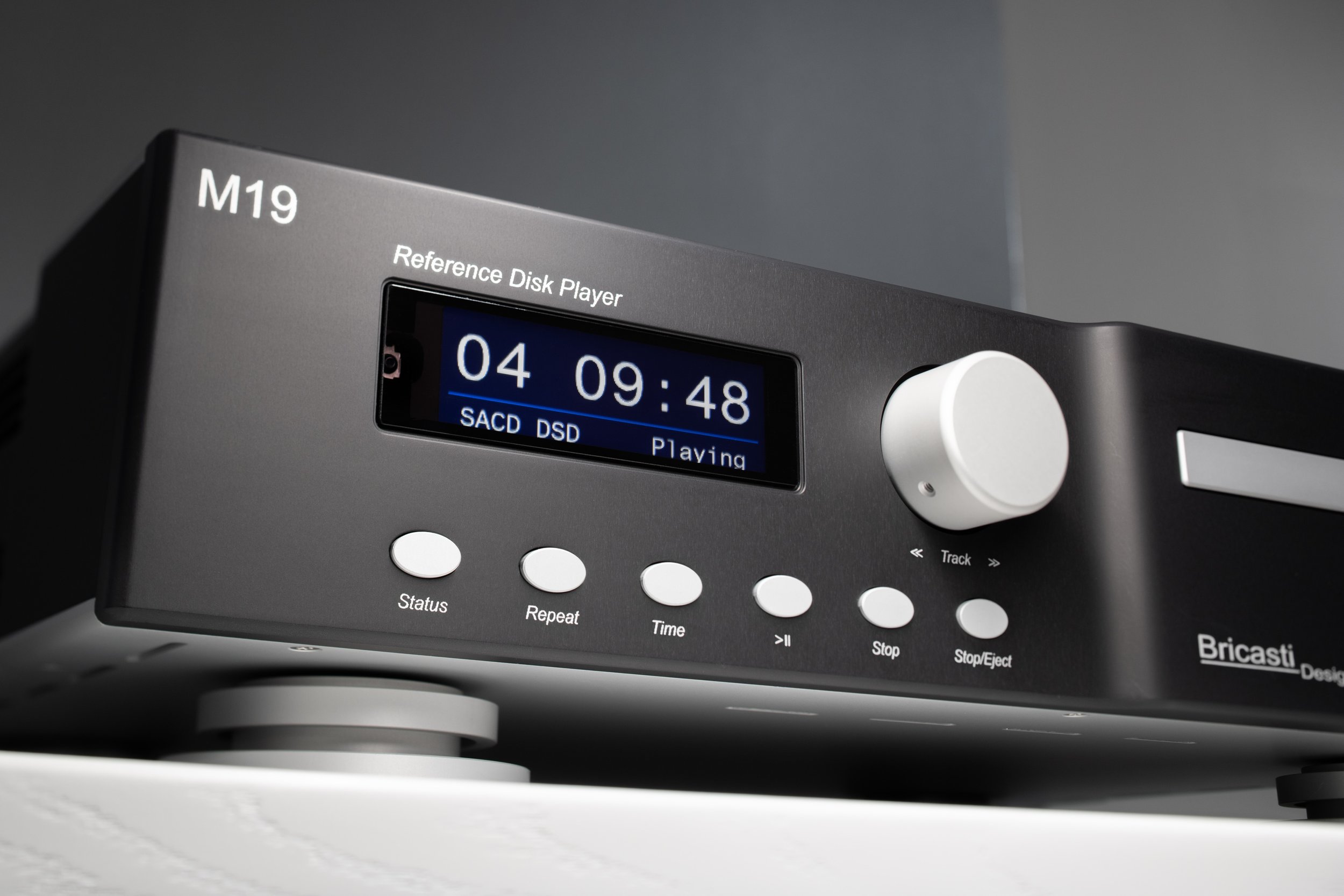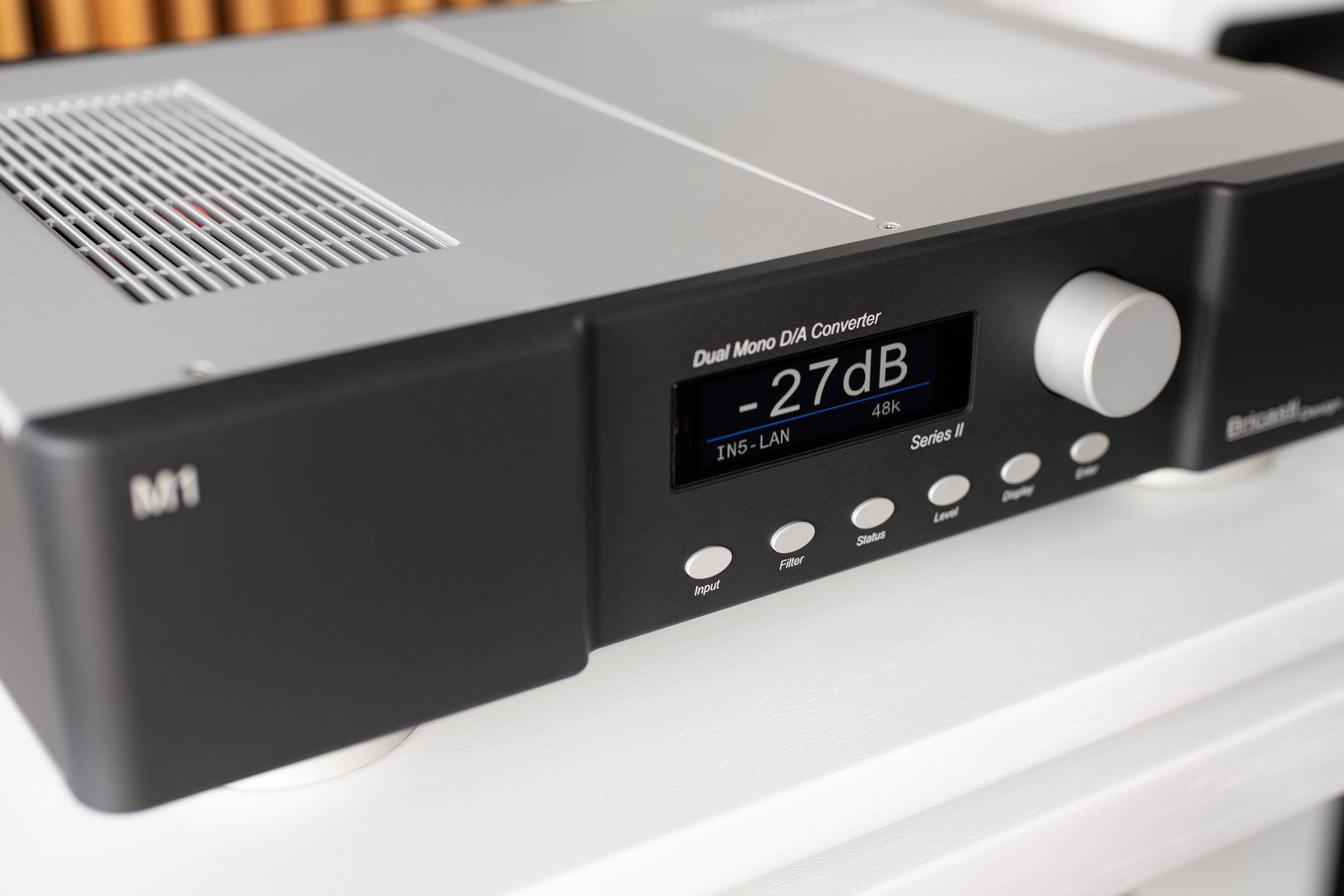
HI-FI DELUXE: BRICASTI M19, M1S2, M20, M25
BRICASTI DESIGN - HISTORY - REVIEWS - TECHNOLOGIES - PRODUCTS - CLASSIC SERIES - SOURCES - PREAMPLIFIERS - AMPLIFIERS - PLATINUM SERIES

Hi-fi deluxe:
BRICASTI
M19, M1S2, M20 AND M25
HIFI DELUXE
Bricasti Design M19 SACD/CD transport, M1 Series II DAC, M20 preamplifier and M25 power amplifier
Jason Kennedy - THE EAR MAGAZINE
Bricasti products reveal their heritage in the casework design, a style that comes from company founders Brian Zolner and Casey Dowdell whose backgrounds were with Lexicon and who work closely with former Madrigal Labs engineers. The latter manufactured Mark Levinson electronics up until the marque was bought by Harman and is generally considered to be the brands halcyon years. Bricasti electronics have a lot of the Mark Levinson in not only their appearance but also in their attention to detail. Where they fail to match that esteemed brand is in the marketing department. Unusually for a north American company Bricasti appear to devote very little attention to selling their products to the audio buying public, I’m told that this is because they prefer to stick with the pro market that got the company off the ground in 2004.
For we enthusiasts that’s a good thing because it makes Bricasti components less expensive than they would be if every high end magazine and site carried their logo, the only drawback is that in UK and Europe the brand has a pretty low profile. UK distributor Connecting Music is determined to do something about this and instead of bringing me the new M19 SACD/CD transport to review he delivered a full system, and I am very glad that he did.
Bricasti, the name derives from the founder’s Christian names, make a solid range of audio electronics with most of the bases covered albeit there is as yet no integrated amplifier, nor for that matter a power amp that your average human can lift. The M25 covered here is the biggest stereo amp in the range and required two humans to get in and out of the box yet has a fairly modest 150W power rating. It is beautifully built and finished in the two tone anodised aluminium common to the Classic Series models, those with deeper pockets have the option of the Platinum Series with plated facias that is said to be aesthetically and sonically superior.
M19 sacd/CD REFERENCE transport

The M19 is an SACD and CD transport which is a rare breed because there is no standard for digital transmission of the DSD signal that comes off an SACD. Bricasti has addressed this with a proprietary I2S link that connects to their M1 DACs and uses an RJ45 connector of the sort usually found on ethernet cables. Apparently the HDMI connection used by some for I2S is compromised by that particular termination and RJ45 is much better suited to the job. I2S (Inter-IC-Sound interface) connections are generally only used for internal links within digital components but a number of high end brands use it for this type of external signal routing, the advantage being that you eliminate the encoding and decoding required for traditional digital connections such as SPDIF or USB.
Inside the M19 Bricasti have installed two independent linear power supplies, one for the motor drive and disc loader and the second for everything related to control and signal processing, the idea being to stop the noisy nature of motor control etc from polluting the audio related side of the transport. As with all Bricasti electronics the chassis is made from milled aluminium for rigidity and sits on Stillpoints isolation feet. Functionally the M19 is a pure transport, it doesn’t attempt to upsample or convert the signal that’s read off the discs its spins, rather the aim is to deliver that signal to a converter with minimum of corruption and maximum fidelity.
M1 SERIES II STEREO D/A

The M1 DAC is what put Bricasti on the hi-fi map in the first place and today it is in its second generation which inhabits a higher chassis and has the luxury of onboard streaming and every modern digital input alongside the aforementioned RJ45. This input serves two functions on the M1 Series II (above), as an I2S for the M19 transport or as a network connection for streaming purposes, presumably anyone needing both sources would need a dedicated streamer.
A glance inside the box reveals that this is an entirely dual mono DAC with separate power supplies and signal processing boards for each channel, you will also note that the signal boards are white which is very unusual. This is because they are ceramic which gives them much greater dielectric properties and higher thermal conductivity than traditional boards, they are also more green than their largely plastic counterparts. The M1S2 has onboard volume control via remote or the silky smooth rotary and its streamer can be driven with Roon or UPnP control apps.
M20 SOURCE CONTROLLER PREAMPLIFIER

The Bricasti M20 line stage preamplifier also features a ceramic PCB for the resistor-based R-2R ladder-style volume control and signal processing, the latter consisting of signal buffering using discreet components. The M20 has both single-ended and balanced in- and outputs but more of the latter than the former, you only get one pair of RCA inputs but twice as many XLRs. Three inputs seems a little limiting in a high-end preamplifier but the emphasis here is very much on quality rather than quantity, and how many of us have more than three sources worthy of maximum resolution?
M25 STEREO AMPLIFIER

The M25 power amplifier is described as powerful and compact by Bricasti, the fact that it stands over 26cm high and weighs nearly 41 kilos notwithstanding. This is clearly an uncompromising amplifier, one that is fully balanced with a power transformer for each channel and dual mono circuit boards to match. As a result, its output doubles into four Ohms to 300W and doubles again into two Ohms, this indicates a very stiff power supply indeed as few power amplifiers will double their output twice into a halving of load. Connections are of both balanced and single-ended varieties and the speaker cable terminals are a proprietary design that are much easier to tighten onto a spade connector than most.
All but the power amp have dedicated remote controls and a display which in most cases allows scrolling through various operational options. The most flexible in this respect is the M1S2 DAC which has a wide range of digital filters to choose from including three dedicated to DSD, which is a first in my experience. The 15 PCM filters are of linear or minimum phase varieties with the former majoring on tonal appeal and the minimum variety offering stronger timing. The DSD filter options offer three degrees of ultrasonic noise filtering with 1 representing no filtering and 3 starting at 28kHz and sloping down to zero at 48kHz.
The remote handsets provided look virtually identical but usefully have a component number at the top, they all offer functions that can be changed and up/down buttons to select between those functions. Most of the time you just need the M20 remote to change volume or input of course but the input and filter settings are easily set on the remote provided for the M1S2, which in the case of filters makes it very easy to compare the sound of each.
SOUND QUALITY
Reviewing a complete system rather than individual components is a bit different but made for a full immersion Bricasti experience that proved to be entertaining and revealing in equal measure. I put the system with Dali Epikore 11 speakers and connected a streaming front end with Melco N10 server and Lumin U2 mini streamer, using USB to hook this up to the M1S2 DAC. The M19 (below) was connected to the DAC with a Tiglon RJ45 cable supplied by the distributor and as the transport is the latest component in the range I started by playing a few discs, something of a novelty for a couch-bound habitual streamer like myself.
And an exciting experience it turned out to be too, starting with regular CD I was impressed with just how bold and substantial a three-dimensional image the system was able to produce. It was also highly engaging and dynamic yet didn’t have any of the hardness or glare that I associate with CD players, this is a pretty special disc spinning combo though and having spent a few weeks with the M1S2 I can’t imagine it delivering a typical CD sound with almost any source. It proved highly transparent to the recording as you might expect with recording character coming through alongside the groove on Bill Withers Use Me, the age of this track cannot be denied but neither can the full fat funk of the keyboard, drums and percussion.
Moving onto SACD and Bayou Country by Creedence Clearwater Revival proved to be a very good idea, the sound produced is a testament to the brilliance of the recording, revelling in the performance whilst accepting that the bandwidth is limited. That band had it down and the original capture is so powerful that it blasts through the technological limitations of the recording kit at the time. SACD clearly has its advantages when reproduced this well.
FILTER FACTOR
Switching to the streaming source proved similarly inspiring with Don’t Interrupt The Sorrow (Joni Mitchell) sounding vivid and open with strong image solidity, depth and scale. Around this point I remembered about the filter options and made a few comparisons between the linear options and discovered that they mainly changed the way the music was presented in terms of imaging and dynamics, then I tried a minimum phase filter and forgot all about the linear options. The fact that Bricasti provide seven linear and only five minimum phase options suggest that they prefer the former but I loved the minimum options because of the extra engagement that the improvement in timing brought about. They aren’t as tonally rich as the linear filters with a generally leaner and sometimes dustier sound but they made me want to listen a lot more attentively. We are talking small differences in tonal terms as well, instruments and vocals still sounded beautiful. And there’s always the option to try different filters with different piece of music, it’s unlikely that one setting will suit all types in a system as revealing as this.
Picking out individual components in a system like this is not easy but it was clear that the M20/M25 pre/power amps have a combination of grip and dynamic expression that is in the premier league. They have a calm, effortless control that gives the impression that everything is in its right place and time, enough in fact to make more affordable alternatives sound rushed by comparison. Low-level detail is exemplary but this is combined with huge dynamic range which means that the savage glory of King Crimson at their seventies peak is rendered in full effect, which is a powerful experience even if it’s not played at full chat.

I made a couple of comparisons with the M1S2 against other converters that while admittedly not in the same price league provided a contrast that revealed the Bricasti DAC to be remarkably natural and refined, the alternatives sounding hard edged and crude by comparison. It would have been interesting to put it up against other high end converters but I suspect that its super low noise and grasp of both dynamics and tonal shading would stand it in good stead against alternatives at more ambitious prices. For starters it managed to make SACD sound better than I have ever experienced, the M19 transport undoubtedly had a lot to do with this of course but either way I was very impressed.
DSD has never really appealed because it always seemed to be about filigree detail and openness but didn’t deliver the dynamics and timing of great music as well as PCM. The Bricasti M19 and M1S2 proved that was not a fault of the format but of the hardware, playing Jeff Buckley’s Grace on SACD proved to be a revelation, the transparency and dynamics were astonishing which produced a sound that was both intimate when needed and physically moving when the chops came down. Rarely has the spirit of Led Zeppelin been so powerfully channelled by an artist with his own unique style.

Results with CD were not far behind, in fact more recent releases like Rymden’s Mountains and Valleys were outstanding. Most of the great SACDs are based on older tapes and if they have been transferred well the results are stunning, but studio tech has progressed markedly in the last decade or two and modern releases can sound spectacular even from a 16/44.1 disc. The Rymden has dynamics at sensible levels and astonishingly low noise. Laura Marling’s Soothing was positively visceral so real did it sound, so in the room and coherent, and that was from a Qobuz stream, there is more to be had for sure. That said there is always more with a system like this, it simply digs deeper and unveils more of the fine details that coalesce to present a three dimensional sound. The better the recording the stronger the result, Anouar Brahem’s oud on Thimar really pops into the room and the double bass and horn are not much different.
Another spectacular disc is Pink Floyd’s Wish You Were Here on SACD, this made me realise that it would be nice to have a hi res version of the album in my library as well as giving fabulous insight into the quality of sound that Rick Wright managed to create with the analogue synths of that era. The guitar playing is what delivers the emotional impact but the intro to Shine On You Crazy Diamond is something else when rendered so well.

CONCLUSION
Getting to use a complete system of Bricasti electronics was a real treat, this company knows how to build genuinely high end components and clearly has a very good grasp of what it takes to deliver sound that is both immensely detailed and musically fluent. This system has vanishing levels of distortion and noise and this means the music stands out from quiet backgrounds and gets delivered in all its multifaceted glory, you want bone crunching bass; play dub, you want emotional entanglement play impassioned vocals. In fact whatever you play will sound phenomenal given a pair of speakers that is up to the job and decent power and cabling.
Whatever you use the Bricasti electronics are always likely to be the strongest link in the audio chain.































